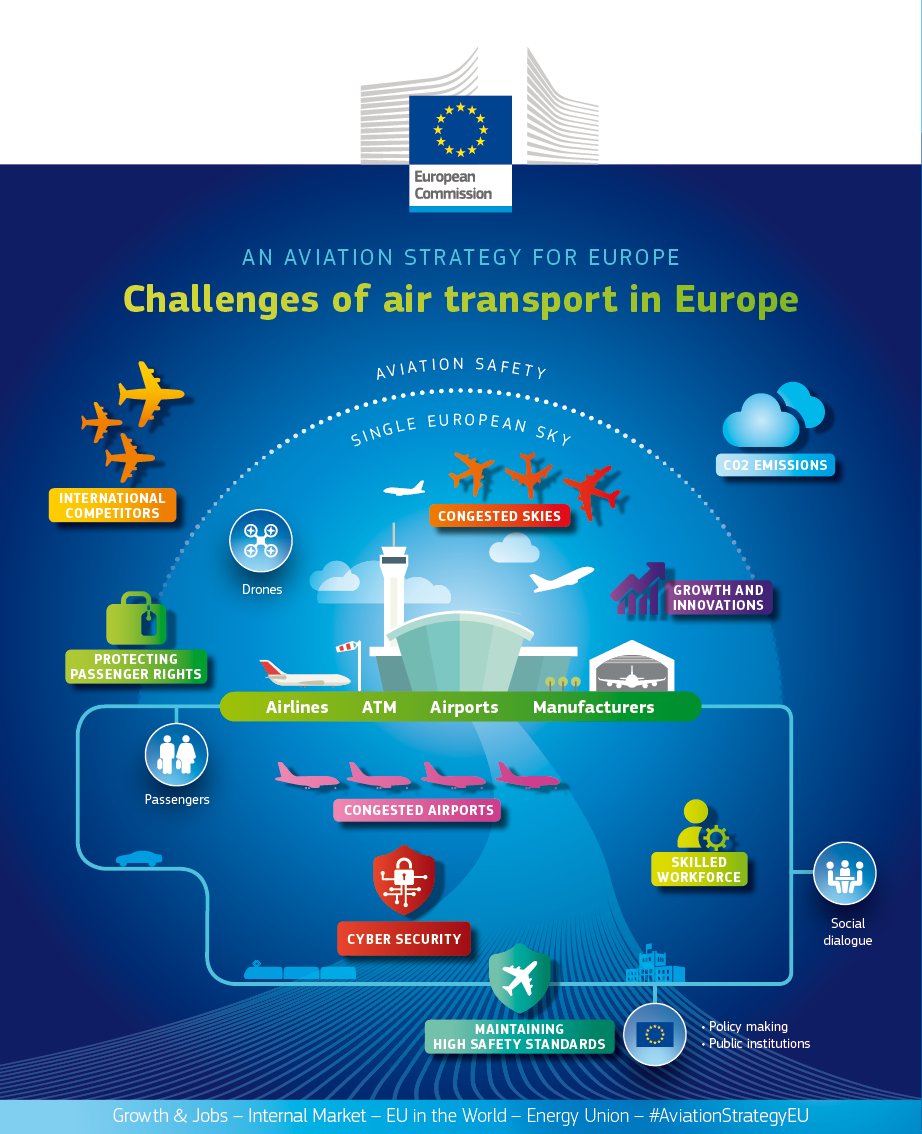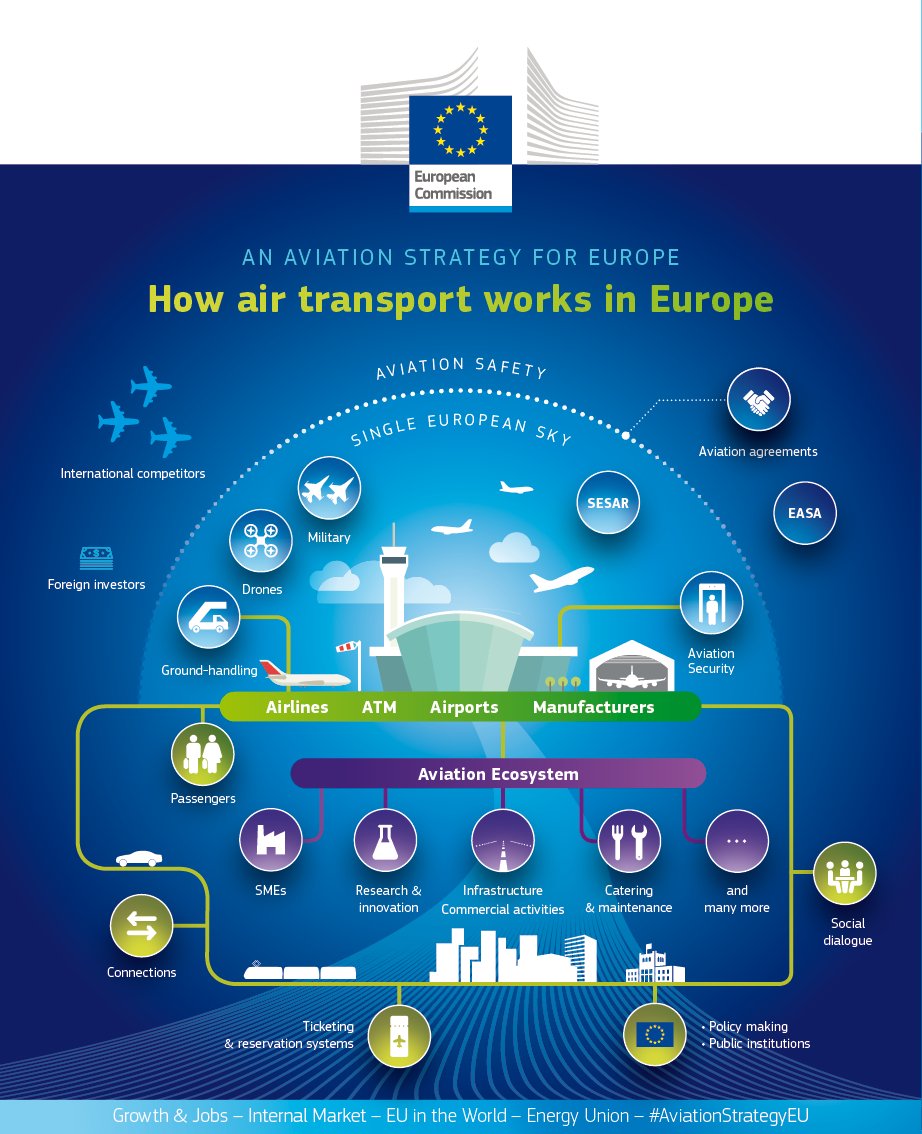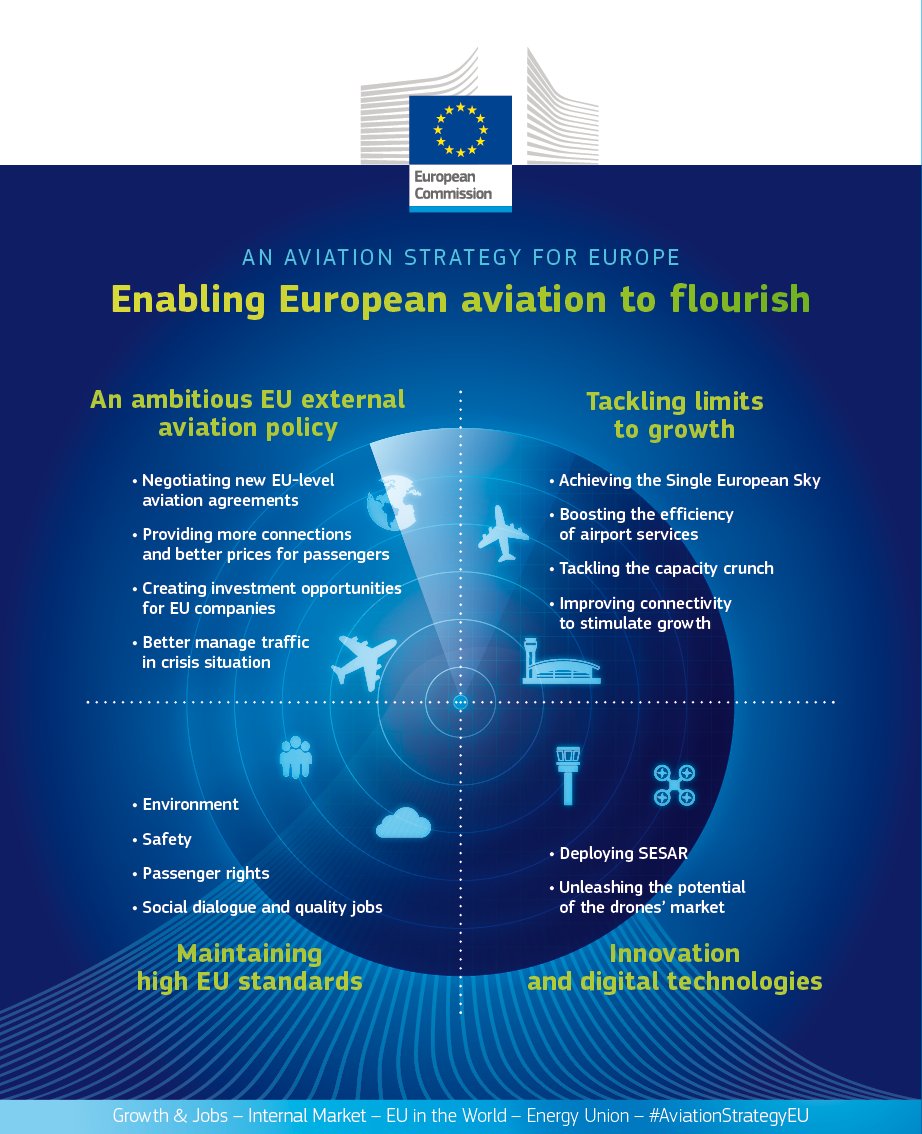The European Commission has launched its new Aviation Strategy for Europe, a milestone initiative to boost Europe's economy, strengthen its industrial base and reinforce its global leadership position. It aims to ensure that the European aviation sector remains competitive and reaps the benefits of a fast-changing and developing global economy. A strong and outward-looking aviation sector will not only benefit businesses, but also European citizens by offering more connections to the rest of the world at lower prices.
The Aviation Strategy is one of the initiatives listed in the Commission Work Programme for 2015. It consists of a Communication, a proposal for a revision of the EU's aviation safety rules (Regulation 216/2008) and requests to negotiate Comprehensive EU-level air transport agreements with a number of key third countries.
Aviation is a strong driver of economic growth, jobs, trade and mobility for the European Union and plays a crucial role in the EU economy. The sector employs almost two million people in the EU and is worth €110 billion to Europe's economy. Over the last 20 years, the EU's liberalisation of the internal market for air services and the substantial growth of demand in air transport within the EU and worldwide, have resulted in the significant development of the European aviation sector. The aviation traffic in Europe is predicted to reach 14.4 million flights in 2035, 50 per cent more than in 2012.
The Aviation Strategy will – for the first time – create a comprehensive road map towards a more competitive EU aviation sector covering all areas of EU air transport policy. In many cases the right initiatives are in the pipeline already – such as for instance the Single European Sky. However, the Aviation Strategy will not only come with new legislative and non-legislative proposals to enhance the competitiveness – it will build additional momentum for implementing measures which are already on the table.
The new Aviation Strategy for Europe will be one of the main discussion points at next year's Routes Europe forum in Krakow, Poland, and will take place between April 23-26, 2016. Margus Rahoja, Director of the Aviation and International Transport Affairs, Directorate-General for Mobility and Transport, EU Commission will make a Keynote Address at the forum's Strategy Summit on the morning of April 24, 2016 entitled the Critical Issues For The Europe Market. You can click on the links to find out more about the Strategy Summit and the Routes Europe forum.
"European aviation is facing a number of challenges and this Strategy sets out a comprehensive and ambitious action-plan to keep the sector ahead of the curve. It will keep European companies competitive, through new investment and business opportunities, allowing them to grow in a sustainable manner. European citizens will also benefit from more choice, cheaper prices and the highest levels of safety and security," said EU Commissioner for Transport Violeta Bulc
"Competitive and efficient aviation is central to Europe's growth. This new Aviation Strategy creates a framework that will enable European aviation to maintain its global leadership,” added Maroš Šefčovič, Vice-President for the Energy-Union.
The Commission's goal is to shape a comprehensive strategy for the whole EU aviation ecosystem, based around four priorities: placing the EU as a leading player in international aviation, whilst guaranteeing a level playing field; tackle limits to growth in the air and on the ground; maintaining high EU standards; and making progress on innovation, digital technologies and investments.
The Commission said the EU aviation sector “must be allowed to tap into the new growth markets”. This can be achieved, it says, through new external aviation agreements with key countries and regions in the world. “This will not only improve market access, but also provide new business opportunities for European companies and ensure fair and transparent market conditions based on a clear regulatory framework,” said the Commission.
These agreements will also provide more connections and better prices for passengers and will support enhanced global connectivity, a driver of trade and tourism, and direct contributor to economic growth and job creation.

In terms of infrastructure, the main challenge for the growth of EU aviation is to address the capacity, efficiency and connectivity constraints. The fragmentation of the European airspace costs at least €5 billion a year and up to 50 million tonnes of CO2, while capacity constraints at EU airports could cost up to 818,000 jobs by 2035, according to the Commission.
“Now is therefore the time for the EU to plan for future air travel demand and avoid congestion. For this reason, the Strategy stresses the importance of completing the Single European Sky project, optimising the use of our busiest airports, and monitoring intra-EU and extra-EU connectivity to identify shortcomings,” it said.
In the interest of European citizens and businesses, it is also crucial to maintain high EU standards for safety, security, the environment, social issues and passenger rights. The Strategy proposes important measures in this sense, with an update of the EU's safety rules in order to maintain high safety standards alongside growing air traffic.
Furthermore an effective and efficient regulatory framework will give the industry more flexibility to thrive and remain competitive globally. The Commission said it will also seek ways to reduce the “burden of security checks and costs,” through the use of “new technology and a risk-based approach”. It will further reinforce the social dialogue and employment conditions in aviation, and pursue a robust global measure to achieve carbon neutral growth from 2020.
A catalyst for the development of aviation, and its function as an enabler of growth, will be innovation and digitalisation, said the Commission. “Europe must in particular unleash the full potential of drones,” it said, and the strategy proposes a legal framework to ensure safety and legal certainty for industry and addresses concerns related to privacy and data protection, security and the environment. In addition, appropriate investments into technology and innovation will secure Europe’s leading role in international aviation.
The European Union has planned to invest €430 million each year, until 2020, in the Single European Sky ATM Research (SESAR) project. “The timely deployment of SESAR solutions can potentially result in the creation of over 300 000 new jobs. The deployment and optimisation of information and communications technologies are also particularly relevant for airport capacity, performance and quality of service,” said the Commission.
The European airspace user associations (AEA, EBAA, EEA, ELFAA, ERA and IACA) has welcomed the European Commission's initiative, but said the strategy lacks ambition and does not propose adequate measures to bolster the competitiveness of air operators - a vital sector in Europe.
The associations contributed to this exercise by responding to the public consultation, drafting position papers and holding face-to-face meetings with EU regulators, in the expectation that the strategy would address the challenges that the EU's aviation sector is currently facing. In a joint reaction to the strategy, the associations welcome the deserved focus on the indispensable contribution of aviation to Europe's economy and mobility but stressed that there is an urgent need for the Commission to now propose more specific and far-reaching remedies.
“While the strategy review correctly identifies some of the significant challenges that Europe's aviation sector is currently facing in terms of the cost and provision of infrastructure (both on the ground and in the air), the integrity of the market, inefficiencies in the value chain and a burdensome regulatory framework (e.g. national and local aviation taxes, the intra-EU ETS), it stops short of proposing concrete measures to address these,” said the associations in a joint statement.






